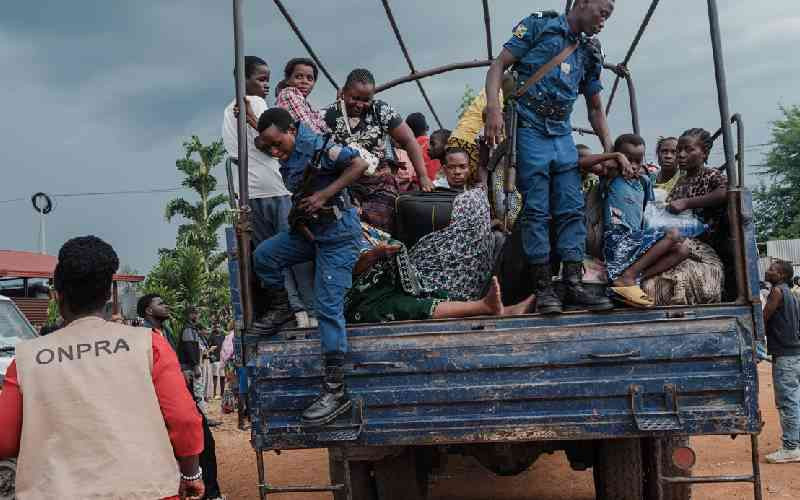Scientists gobsmacked by never-seen footage of earth rupturing during Myanmar quake | CBC News
When you watch the video below, don't get distracted by the cracking concrete or the metal gate rocking back and forth. Keep your eyes focused on the right side of the screen, where you will see an astonishing sight — one that earthquake scientists say has never been caught on camera before.
The video was captured by a surveillance camera on March 28, when a violent earthquake struck the southeast Asian country of Myanmar — causing widespread damage as far away as Bangkok in neighbouring Thailand, and killing some 3,700 people, according to Myanmar's ruling military junta.
The footage shows the moment the 7.7 magnitude quake caused the land on one side to thrust forward with a powerful jolt, as a rupture ripped opened the earth for 460 kilometres along the Sagaing Fault.
"My jaw hit the floor," said Wendy Bohon, an earthquake geologist and science communication specialist in Sacramento, Calif., when she saw it.

Massive earth rupture seen on camera for 1st time during Myanmar quake
Satellite imagery and other data had already helped scientists determine the extent of the rupture and approximately how much the earth moved. But seeing such a dramatic shift of the landscape in action is a first for scientists like Bohon, and may prove to be an invaluable tool in understanding the type of earthquake that ravaged Myanmar.
"We have computer models of it. We have laboratory models of it. But all of those are far less complex than the actual natural system. So to see it actually happening was mind-blowing," she told CBC News.
"I keep going back and watching it," said geologist Judith Hubbard, an assistant professor at Cornell University's department of Earth and atmospheric sciences.
"It's really kind of staggering to see a fault slide in real time, especially for someone like me, who has spent years studying these things, but always from more remote kinds of data, like offsets after the fact or data recorded by sensors," she said in an email interview.
The Sagaing Fault runs some 1,400 kilometres, between the Indian and Eurasian plates, right through Myanmar and into the Andaman Sea. It's a strike-slip fault, meaning that when an earthquake happens, the land mass on one side of the fault slides past the other.
Researchers with NASA's Jet Propulsion Lab used satellite and radar data to determine that the earthquake caused a horizontal displacement up to six metres in some locations along the fault. The Geospatial Information Authority of Japan made similar observations.
Scientists like Hubbard say there is "compelling evidence" it was a supershear earthquake.
That's when the speed of the rupture, which is generally slower-moving, travels faster than seismic waves that the earthquake produces, which can travel up to six kilometres per second.
The video appeared May 11 on a YouTube channel called 2025 Sagaing Earthquake Archive, which has been curating social media videos and security camera footage since the quake struck.
According to a Facebook post linked in the caption, the video was from a camera at a power facility in Tha Phay Wa. That's in the township of Thazi, some 110 kilometres south of the city of Mandalay, and close to the epicentre of the quake and its 6.7 magnitude aftershock.
A Google Maps satellite view of the area shows a power facility located in this area and close to the Saigang Fault.
Hubbard said that watching the video, it doesn't look like the quake was supershear at this location, because you see the seismic waves hit and the terrain shaking before the rupture occurs. But it's possible it was happening at supershear speed elsewhere along the fault.
She said this video offers her and other earthquake scientists "a really striking observation."
"We don't tend to have instruments right along the fault. They are often disrupted by shaking," she said.
This happened right there in front of their eyes, on video, which means they don't only have to rely on analyzing and interpreting complicated recordings and data to determine what happened on the ground.

Earthquake in Myanmar, Thailand kills thousands
Bohon said there's little doubt the video is real and she doesn't believe it's been altered or fabricated in any way.
She said there are finer details in the background that you would have to pay close attention to, or that AI tools wouldn't know to generate — such as a bird flying away as the shaking begins about 12 seconds into the video, and power lines straining and eventually causing a transmission tower to buckle a few seconds later.
"There's also another kind of more subtle thing," Bohon said. "It's called the geomorphology, the shape of the surface of the earth."
Earthquakes, she explained, change the landscape and move hills and rivers.

She pointed to the small hill in the background of the CCTV footage, situated along the fault, that thrusts forward.
"That hill in the background, that you see move towards the camera," she said. "If you look at it, it's kind of long and linear, and then it just cuts off right about where the fault is."
She said that if you can view the location using satellite imagery, you could look to see where the other half of that hill is in relation to the portion that moved forward in the quake.
The observations Bohon made to verify what she was seeing in the video also told her a lot about the earthquake itself and that this kind of footage has "tremendous scientific value."
She said that despite the violent shaking and and shifting of the earth, it was interesting to see that small structures were relatively unscathed considering the force of the quake.
"Watching the destruction in the nearground and watching it in the background, and then even further away, was a really interesting look into how earthquakes impact things right next to the fault and at varying degrees away from the fault itself," she said.
As "devastating and horrific" as earthquakes like the one in Myanmar can be, Bohon said they always present a learning opportunity that can hopefully be used to improve safety and protect lives.
While this footage is a first, Bohon expects there will be more to come because of the prevalence of CCTV and other types of cameras that are capturing video around the clock and from multiple angles.

Rescue crews scour rubble for survivors after Myanmar quake










